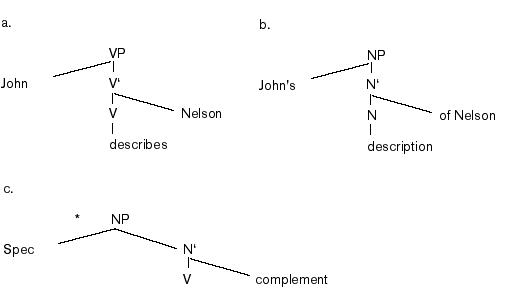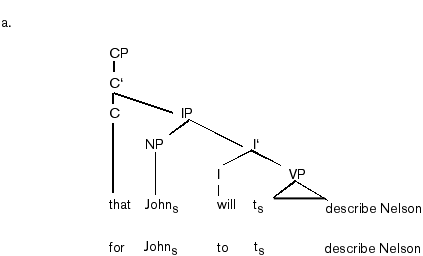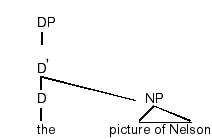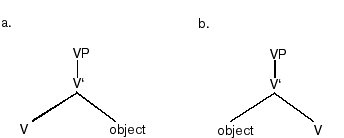
In generative SYNTAX (see GENERATIVE GRAMMAR), X-bar theory is the module of the grammar that regulates constituent structure. It aims at characterizing a possible syntactic configuration. In interaction with the other principles of the grammar, X-bar theory determines structural representations.
Syntactic structure is defined in terms of two principles: (i) constituents are endocentric, phrases are organized around a head (i.e. they are projections of heads); (ii) constituents are built up according to the schema (1).

A head X° (a word,
or a -- possibly abstract -- morpheme) combines with one
maximal projection, its complement, to form the intermediate projection,
 ("X-bar"),
or X'. X' combines with another maximal projection,
its spec(ifier) to form the maximal projection, represented as XP,
or as
("X-bar"),
or X'. X' combines with another maximal projection,
its spec(ifier) to form the maximal projection, represented as XP,
or as  ("X-double
bar") or as X". The variable X ranges
over syntactic categories of two types: lexical categories N(oun),
V(erb), A(djective), P(reposition); and functional categories such
as I(inflection) or C(complementizer). Properties of the head percolate
along the projection line: if the head is a V(erb), the projection
will be a V(erb)P(phrase) (2a); a N(oun)head projects a N(oun)P(hrase)
(2b), and so on. (2a) and (2b) are grammatical representations,
but (2c) is ungrammatical:
("X-double
bar") or as X". The variable X ranges
over syntactic categories of two types: lexical categories N(oun),
V(erb), A(djective), P(reposition); and functional categories such
as I(inflection) or C(complementizer). Properties of the head percolate
along the projection line: if the head is a V(erb), the projection
will be a V(erb)P(phrase) (2a); a N(oun)head projects a N(oun)P(hrase)
(2b), and so on. (2a) and (2b) are grammatical representations,
but (2c) is ungrammatical:

The X-bar format makes it possible to express crosscategorial generalizations. Thus, for instance, the selectional properties of the V describe in (2a) are parallel to those of the N description in (2b).
(1) is the format of X-bar theory adopted in the principles-and-parameters approach to syntax (see MINIMALISM). There are a number of variations to the implementation of the core idea. For instance, for some approaches, X-bar theory need not be committed to the strong claim (due to Stowell 1981) that all constituents are endocentric, only that this is the default option. LEXICAL FUNCTIONAL GRAMMAR respects X-bar theory but allows for a finite set of exocentric phrases with special properties (notably S in nonconfigurational languages). In some versions of X-bar theory, it is assumed that all syntactic structure is binary branching (Kayne 1984). Other versions allow multiple complements and multiple specifiers (see Carrier and Randall 1992, for example). There is also variation with respect to the number of bar levels (see Stuurman 1985 for discussion).
Originally, the X-bar format was mainly elaborated for the projection of lexical categories (see Jackendoff 1977: 53), functional categories (inflectional morphemes such as the tense and agreement morphemes of verbs, or function words such as determiners or conjunctions) being integrated within lexical projections, typically as their specifiers. The sentence was interpreted either as an exocentric category -- that is, a category without a head or as a projection of the verb (Jackendoff 1977). In the principles-and-parameters approach (Stowell 1981 and Chomsky 1986), the X-bar format is extended to all syntactic categories, functional as well as lexical. A sentence is an extended projection of a verb (Grimshaw 1991): it is a projection of V augmented with projections of inflectional morphemes. The sentence is dominated by a projection of the functional category C(omplementizer), which encodes its illocutionary force. In embedded clauses like (3a), C is filled by the complementizer (the subordinating conjunctions that, if, for). C takes as its complement IP, a projection of the verbal inflection (tense, agreement morphemes; Van Riemsdijk and Williams 1986; Haegeman 1994 for introductions).


In (3a) the subject NP, which originates in the specifier of VP (2a) (McCloskey 1997 discusses the status of subject in generative syntax; see also GRAMMATICAL RELATIONS), moves to the specifier position of IP. Movement leaves a trace (ts). (3b) illustrates the X-bar format as applied to an interrogative root clause. See also HEAD MOVEMENT and WH-MOVEMENT.
In (3b) the direct object, which character, has undergone wh-movement to the specifier of CP, and the auxiliary will has undergone head movement from I to C.
Abney (1987) shows that the projection of the noun (NP) must be reinterpreted as an extended projection of NP -- that is, a projection of N augmented with functional projections, such as, among others, the projection of the D(eterminer), as shown in (4).

The X-bar format determines the hierarchical organization of structure but not the linear order of the constituents. English is an SVO language: in (5a) V precedes the direct object; West Flemish is an SOV language: in (5b) V follows the direct object. See also LINGUISTIC UNIVERSALS AND UNIVERSAL GRAMMAR.

One option to account for the crosslinguistic variation is to postulate parametric variation in the base structure: whereas the underlying structure of the VP in (5a) is as in (6a), that of (5b) is as in (6b) (see Kayne 1984).
(6)
a. I think that John wants to buy this book.
b. k peinzen da Valère wilt dienen boek kuopen.
I think that Valère wants that book buy
An alternative option is to maintain that the base structure is invariantly head-initial, hence, the direct object always originates to the right of the head, V. Crosslinguistic word-order variation as that in (5) is derived by additional movement rules. In OV languages (see (5b), the object moves leftward to the specifier position of a functional projection dominating VP. The resulting representation (7) maps into an OV order.

The mechanism of head movement, in conjunction with X-bar theory, accounts for the formation of complex verbs as found in POLYSYNTHETIC LANGUAGES (see Baker 1996).
The X-bar format is often claimed to find a predecessor in the superscripting convention of Harris (1951: chap. 6) whose aim was "to reduce the number of classes which we require when we state the composition of each utterance of the language" (1951: 262, in Stuurman 1985: 18). However, Stuurman (1985) has shown that structuralist superscripting is a lexical device and differs considerably from the generative X-bar format. The basis for the generative X-bar format was developed in Chomsky's (1970) "Remarks on Nominalization" whose aim was to capture crosscategorial generalizations without using transformations. X-bar theory is further elaborated by Emonds (1970) and Jackendoff (1974, 1977). Later developments concern the generalization to functional structure (Stowell 1981; Chomsky 1986), the binary branching format (Kayne 1984), the antisymmetry hypothesis (Kayne 1994), and the related universal base hypothesis (Kayne 1994).
Muysken (1981) interprets the concept of phrase-structure level in terms of a relational property expressed by two features [+projection], [+ maximal], where [ - projection, - maximal] stands for X°, and [+projection, +maximal] stands for XP, the maximal projection. Intermediate projections are [+projection, - maximal]. Chomsky (1995), capitalizing on Muysken's proposal, explores ways of reducing the X-bar format via the concept of bare phrase structure, in which the levels of projection are derived notions and in which nonbranching projections are eliminated (Speas 1990 is a precursor for this view). Ongoing controversies concern the status of adjunction (May 1985; Kayne 1994), the status of intermediate projections (Chomsky 1995; Kayne 1994), and the status of multiple specifiers (Chomsky 1995). For the structure of nonconfigurational languages, see Hale (1983). For investigations of the application of the X-bar format to morphology, see, among others, Aronoff (1976).
In imposing restrictions on the format for phrase structure rules, the X-bar format restricts the expressive power of the technical devices available for natural language grammars. The X-bar format imposes that a constituent is a projection of a head and that the internal structure of constituents is invariant crosscategorially. Taken as part of Universal Grammar, this constrained view of the format of phrase structure contributes towards explaining the rapidity and uniformity of the acquisition of syntactic structures.
Abney, S. (1987). The English Noun Phrase in its Sentential Aspect. Ph.D. diss., MIT.
Aronoff, M. (1976). Word Formation in Generative Grammar. Cambridge, MA: MIT Press.
Baker, M. (1996). The Polysynthesis Parameter. Oxford: Oxford University Press.
Carrier, J., and J. H. Randall. (1992). The argument structure and syntactic structure of resultatives. Linguistic Inquiry 23:173-234.
Chomsky, N. (1970). Remarks on nominalization. In R. Jacobs and P. Rosenbaum, Eds., Readings in English Transformational Grammar. Waltham, MA: Ginn, pp. 184-221. Also in N. Chomsky, Studies on Semantics in Generative Grammar (1972). The Hague: Mouton, pp. 11 - 61.
Chomsky, N. (1986). Barriers. Cambridge, MA: MIT Press.
Chomsky, N. (1995). Bare phrase structure. In G. Webelhuth, Ed., Government and Binding Theory and the Minimalist Program. Oxford: Blackwell, pp. 383-439.
Emonds, J. (1970). Root and Structure Preserving transformations. Ph.D. diss., MIT.
Grimshaw, J. (1991). Extended Projections. Unpublished manuscript, Brandeis University.
Haegeman, L. (1994). Introduction to Government and Binding Theory. Oxford: Blackwell.
Hale, K. (1983). Warlpiri and the grammar of nonconfigurational languages. Natural Language and Linguistic Theory 1:1-43.
Harris, Z. (1951). Methods in Structural Linguistics. Chicago: University of Chicago Press.
Jackendoff, R. (1974). Introduction to the X" Convention. Mimeo, distributed by the Indiana University Linguistics Club, Bloomington, IN.
Jackendoff, R. (1977). X" Syntax: A Study of Phrase Structure. Cambridge, MA: MIT Press.
Kayne, R. (1984). Connectedness and Binary Branching. Dordrecht: Foris.
Kayne, R. (1994). The Antisymmetry of Syntax. Cambridge, MA: MIT Press.
May, R. (1985). Logical Form. Cambridge, MA: MIT Press.
McCloskey, J. (1997). Subjecthood and the subject position. In L. Haegeman, Ed., Elements of Grammar. Dordrecht: Kluwer.
Muysken, P. (1981). Parametrizing the notion head. Journal of Linguistic Research 2:57-75.
Speas, M. (1990). Phrase Structure in Natural Language. Dordrecht: Foris.
Stowell, T. (1981). Origins of Phrase Structure. Ph.D. diss., MIT.
Stuurman, F. (1985). X-Bar and X-Plain. A Study of X-Bar Theories of the Phrase Structure Component. Dordrecht: Foris.
Van Riemsdijk, H., and E. Williams. (1986). Introduction to the Theory of Grammar. Cambridge: MIT Press.
Baker, M. (1988). Incorporation: A Theory of Grammatical Function Changing. Chicago: University of Chicago Press.
Emonds, J. (1976). A Transformational Approach to English Syntax. New York: Academic Press.
Emonds, J. (1985). A Unified Theory of Syntactic Categories. Dordrecht: Foris.
Fukui, N. (1986). A Theory of Category Projection and its Applications. Ph.D. diss., MIT.
Haegeman, L., Ed. (1997). Elements of Grammar. Dordrecht: Kluwer.
Hornstein, N. (1977). S and the X" convention. Linguistic Analysis 3:137-176.
Koizumi, M. (1995). Phrase Structure in Minimalist Syntax. Ph.D. diss., MIT.
Koopman, H., and D. Sportiche. (1991). The position of subjects. Lingua 85:211-258.
Koster, J. (1987). Domains and Dynasties. Dordrecht: Foris.
Kuroda, S. -Y. (1988). Whether we agree or not. Linguisticae Investigationes 12:1-47.
Lasnik, H., and J. J. Kupin. (1977). A restrictive theory of transformational grammar. Theoretical Linguistics 4:173-196.
Radford, A. (1988). Transformational Grammar. Cambridge: Cambridge University Press.
Selkirk, E. (1982). The Syntax of Words. Cambridge, MA: MIT Press.
Siegel, D. (1974). Topics in English Morphology. Cambridge, MA: MIT Press.
Speas, M. (1986). Adjunctions and Projections in Syntax. Ph.D. diss., MIT.
Sportiche, D. (1988). A theory of floating quantifiers and its corollaries for constituent structure. Linguistic Inquiry 19:425-449.
Stowell, T. (1983). Subjects across categories. The Linguistic Review 2:285-312.
Travis, L. (1984). Parameters and Effects of Word Order Variation. Ph.D. diss., MIT.
Williams, E. (1981). On the notions 'lexically related' and 'head of a word,' Linguistic Inquiry 2:245-274.
Zwart, J.-W. (1997). The Germanic SOV languages and the Universal Base Hypothesis. In L. Haegeman, Ed., The New Comparative Syntax. London: Addison, Longman, and Wesley, pp. 246-267.